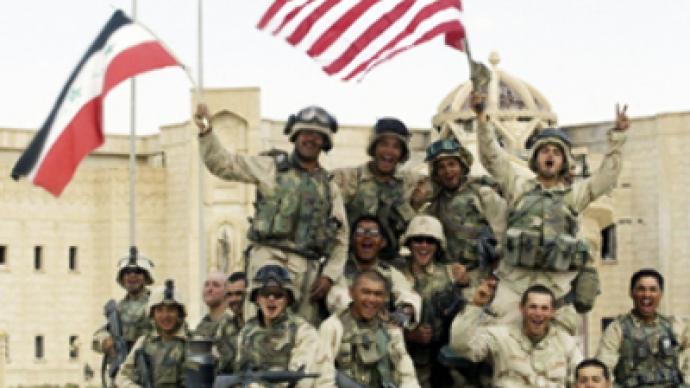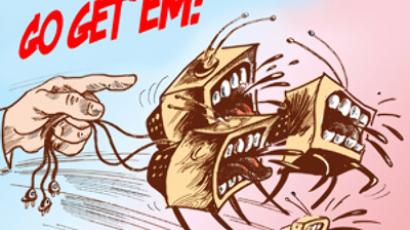Iraq 2003: behind the scenes

The Iraq war of 2003 was one of the most publicized conflicts in human history. The world watched it live on kitchen TV-sets and listened to it on the radio in real time while driving to work.
Hundreds of journalists were 'embedded' with the troops and reported their live experiences on an hourly basis. Yet there was one angle of that war that escaped close attention from mainstream media around the world – the way the war looked from inside Baghdad and the surrounding area.
Most journalists who made it to the Iraqi capital found themselves confined to the Palestina Hotel by the order of Saddam Hussein's Information ministry. They waited for daily briefings by Iraqi officials, recorded stand-ups on the roof of the hotel's restaurant or on top of their satellite trucks, and then waited again, now for promised trips to the most bombed areas or, if a trip was unlikely to happen, for the briefing next day.
They were not lazy and they were not cowardly. Most showed a lot of courage when events quickened their pace on the 4th of April and onwards. Many stayed in the hotel even when American tanks started loosing round after round of ammunition on the building on the last day of the Baghdad operation.
They were well disciplined – and I am not just talking about orders from Iraqi officials: we all knew that the regime was on the brink of collapse; it actually collapsed in our full view several days later.
Even under the tight control of the Iraqi minders, it was possible to sneak out and shoot some footage on your own, and a few of the journalists did it more or less often. But the others just stayed there, at the Palestina, eternally waiting for the next briefing. They complained that their editors were not interested in any pictures from Baghdad beyond what was allowed by the Iraqis.
We watched TV when we could, and it was evident that my embedded colleagues, my fellow-'palestinians,' were getting much more screen time than anyone reporting from Baghdad.
I was part of a very small crew put together by my close friend, Thai newspaper columnist and TV presenter Nitipoom Navaratna and I to make a documentary about the war. We weren't tied up by scheduled live feeds and on our first day, after a thousand-kilometre drive from Damascus, after opening just one single room at the Palestina and making a proper show of checking in, we managed to 'vanish' from the eyes of the Iraqi minders and proceeded to our actual lodgings downtown.
We stayed at a house owned by a Thai-Arab couple 800 meters from the central post and telegraph office. The house had a flat roof and that's where we watched and recorded the American nighttime sorties.
Four Thai students of the Baghdad University, who had failed to leave before the war started, volunteered to be our scouts and 'field producers.' They knew the city perfectly well and had many friends among the locals, including their fellow students who were in the military: reserve officers, by that time already on active duty.
In this way we gained access to the biggest secret of the war: the real picture of the battlefield seen through the eyes of an Iraqi soldier. The officers we talked to often spent a day or two with their families after a week at the front. The war was closing in on the city and every trip back from the front line was shorter than the previous one.
Our new acquaintances spoke of the Americans doing their best to avoid close-range engagements and preferring to shoot from helicopters or APCs. They described the sporadic but fierce fire fights that broke out when Iraqi and American units met suddenly face to face in a village or small town and the long hours under artillery shelling and missile attacks.
They spoke of hundreds of killed American soldiers and thousands of fallen Iraqis when the official statistics offered much lower figures. Only after the war did I learn that the casualties of the U.S. special forces had been counted separately from the losses of the Army and the Marines, and that their much-higher death toll escaped immediate publication.
Several times, between the 31st of March and the 6th of April, we drove in a locally-rented very ancient Toyota minibus with completely darkened windows to the areas where fighting had been reported. Once we came to a small town slightly over a hundred kilometres from Baghdad where, on the day before, three American helicopters had attacked the local kindergarten. It was built of big unpolished concrete blocks and probably looked like a military installation from the air.
The Americans never noticed the playground beside the building and attacked it with missiles. Three children died; the rest were saved by a unit of Fedain, Saddam Hussein loyalist paramilitary, stationed nearby: they started shooting their Kalashnikovs at the helicopters and while the pilots shifted fire to the shooters hiding under the walls of neighbouring buildings, other members of the unit led the children and teachers out of the dangerous area.We talked to the Fedain soldiers after they had held us at gunpoint for half an hour waiting for the area counterintelligence officer to come and check our identifications.
When he said we were OK, the Fedain told us that right after the helicopter attack a small unit of U.S. special forces had entered the town – most probably to search the attacked building for documents and equipment, but met with this very patrol of the Fedain who had stayed behind just in case. The Americans lost two or three men and retreated, taking with them the bodies of their dead.
The Fedain, as well as the counterintelligence officer, and many others whom we met in those few days, were all absolutely determined about the war: for them it was an illegal military invasion and they were prepared to fight the enemy to the last drop of blood.
We also met several Iraqi dissidents who returned to the country voluntarily after years of exile in Syria and Jordan, each of them as much an enemy of Saddam Hussein as on the day he was forced to leave his motherland, but now returning to fight – for the motherland, not for Saddam Hussein.
Driving around Baghdad we saw the city preparing for the worst. Earthen fortifications were being built in shifts, so the work never stopped. Soldiers were setting up positions for machine guns and mortars. Long-barrelled anti-aircraft guns were being installed on pre-arranged platforms, their barrels not looking upward and waiting for unseen targets high up in the sky, but trained at a slight angle at the barchans a couple kilometres away, from where enemy tanks were expected to arrive.
It was all very much like in the stories of the Battle of Moscow I had heard from veterans and read as a child, when the military and the people of my home town were getting ready for the German assault in the fall of 1941. The similarity became even more striking when I understood how high was the spirit and determination of the few defenders of Baghdad I encountered. Some of them were graduates of Soviet universities and military academies, well acquainted with the war history of my homeland.
They were not going to fight for Saddam Hussein but they were prepared to defend – and die defending – their ancient home, the Baghdad of Medieval glory; Baghdad, the cultural centre of the Middle East, the city they were proud of – just like my grandparents in 1941, who worked and fought hard – for Moscow, not for Joseph Stalin.
Foreign Mudjaheddin, who fought against ‘Western Crusaders' were joining them, led by the Fedain who fought for Saddam. Their determination was very different, but also high.
The city was ready to stand against the strongest military machine of our time, and there was a chance that it could stand for quite a long while because, by then, the American soldier had already shown everyone in Iraq that he was not prepared to die for the cause he was fighting for. Contrarily, among the Iraqis there were many who knew what they were fighting for, and completely ready to die for it.
But the Battle of Baghdad never happened. The U.S. troops entered the city after they cut through several Iraqi divisions, which let them pass without a single shot. The tanks were never confronted by the AA guns trained on their approach lane. They rolled into the city and found it empty of all life. It looked like a ghost town from the Arabian Nights.
TV was showing a great celebration on one of the city squares and rolled the same piece of footage showing the demolition of one of the statues of Saddam Hussein – over and over and over again… But the city around the place where the cameras worked was empty and still.
There were people but they were locked in their homes, waiting for a sign from someone who would tell them what to do. The U.S. troops rode in their vehicles along empty streets while the world celebrated the victory of the U.S.-led alliance over the Iraqi regime.
That is another secret of the Iraqi war that never made it to the TV screen: how could the spirit of the Iraqi troops have changed so abruptly in just a few days, or to be exact – in the 48 hours between the 5th and 7th of April? Where had all the determination gone?
I left Baghdad without learning the answers to these questions. I learned them much later, when one of our Arab friends, now an ex-military officer and a successful businessman, made it out of Baghdad and all the way to Bangkok for the first time since the start of the war.
He told me of the total collapse of the Iraqi armed forces' chain of command which happened overnight, on the 4th and 5th of April. Divisions waited for their orders but the orders never came, so the division commanders couldn't issue orders to the regimental and brigade commanders, who in turn had no orders for their battalions and companies.
The spirit of the troops and the determination was gone the same instant that everyone understood that they had been betrayed, and betrayed by someone on such a high level of authority that there was no point left in fighting. My friend said that there was no time to find new leaders and that all communications had been compromised. That was how the Iraqi army lost its will to fight.
Only the Fedain, at least partially, maintained their command structure and communications, and fought to the end. Later, those who managed to stay alive continued their fight as guerrillas, having absorbed many Mudjaheddin who had been late for the defence of Baghdad.
My friend said that the campaign of 2003 was won by the U.S. with money, not weapons. He insists that a few top figures among Saddam's top brass received exorbitant fees for betraying the whole system of the Iraqi defence, the immediate plans of the Iraqi military leadership and all the communication codes, with the exception of the codes used by the Fedain.
But we cannot be sure. We didn't see it on TV, did we?
Evgeny Belenkiy, RT.














